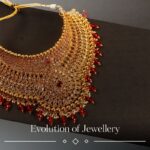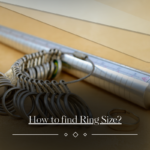 Jewellery, one of the essential accessories for a person daily, has undergone many changes and trends. Many people who are enthusiastic about or love jewellery do not know it has evolved. Jewellery evolved and has its roots in Egypt. Egyptians emphasised luxury and royalty and hence, soon after its revolution, it symbolised religious power in the community. Today, we see people wearing pieces of jewellery according to their preferences. Some wear it according to trends while some wear it according to styles and designs. People have different preferences for jewellery according to events; some wear them to represent luxury and royalty. With so many choices, jewellery has evolved through the years and has uncountable options. But, what is the history behind the evolution of jewellery?
Jewellery, one of the essential accessories for a person daily, has undergone many changes and trends. Many people who are enthusiastic about or love jewellery do not know it has evolved. Jewellery evolved and has its roots in Egypt. Egyptians emphasised luxury and royalty and hence, soon after its revolution, it symbolised religious power in the community. Today, we see people wearing pieces of jewellery according to their preferences. Some wear it according to trends while some wear it according to styles and designs. People have different preferences for jewellery according to events; some wear them to represent luxury and royalty. With so many choices, jewellery has evolved through the years and has uncountable options. But, what is the history behind the evolution of jewellery?
History of the Evolution of Jewellery
As mentioned above, we have a little idea that jewellery has its emerging roots in Egypt. It was almost 4000-5000 years back when the signs of emergent of jewellery were seen in Egypt. They laid high emphasis on royalty and tried to understand different metals. Gold was mostly used for making ornaments over other metals. Egyptians started to design and make pieces of jewellery with different metals, mainly gold with valuable gemstones. Not only in the living world, Egyptians also buried precious metals and gemstones after death that people of high royalty would take with them in their afterlife. Later, silver was used to make ornaments which were mostly used in Maghreb, a ruler area in South Africa. They used silver to make elaborate brooches and craft rings, earrings and necklaces.
Evolution of Jewellery in the Medieval Era
Jewellery in the medieval era was mainly reflected in Europe. People with high nobility in European societies wore expensive and valuable metals like gold. And the lower hierarchy or the lower or middle class wore less valuable metals like copper. It reflected the royalty status of people and linked them to a particular section of the hierarchy in society.
RENAISSANCE-ERA
The era marked the development and discoveries of new continents and rapid change in art and culture. The significant jewellery worn were pendants with chains with prominent gemstones like diamond, topaz and emerald.
17 th Century
The 17th century marked the era of rapid changes in clothing fashion which in turn led to a change in taste in jewellery worn. The 17th era also marked the introduction of new cutting techniques that led to new shapes and the use of new materials. Gold, silver, pearls etc were significantly used. Even in the era of major changes wearing jewellery and using expensive metals remained a symbol of royalty and nobility. Not only in higher societies but also the design of jewellery in crosses and other religious symbols also lined jewellery with religion.
17 th century marked the era of foreign and global trade. It resulted in an exchange of precious metals and gemstones. People not only traded tangible items but also different ideas and views. People while travelling, got the idea of various artifacts, craftsmanship and designs. It led development and evolvement of pieces of jewellery resulting in various new designs. The era also showed no gender distinctions and jewellery worn by both men and women, which represented them from a particular society and cultural group.






